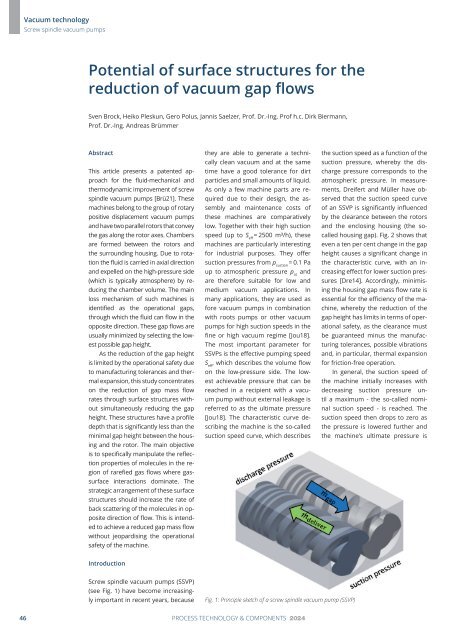PuK - Process Technology & Components 2024
A technical trade magazine with a history of more than 60 years.
A technical trade magazine with a history of more than 60 years.
You also want an ePaper? Increase the reach of your titles
YUMPU automatically turns print PDFs into web optimized ePapers that Google loves.
Vacuum technology<br />
Screw spindle vacuum pumps<br />
Potential of surface structures for the<br />
reduction of vacuum gap flows<br />
Sven Brock, Heiko Pleskun, Gero Polus, Jannis Saelzer, Prof. Dr.-Ing. Prof h.c. Dirk Biermann,<br />
Prof. Dr.-Ing. Andreas Brümmer<br />
Abstract<br />
This article presents a patented approach<br />
for the fluid-mechanical and<br />
thermodynamic improvement of screw<br />
spindle vacuum pumps [Brü21]. These<br />
machines belong to the group of rotary<br />
positive displacement vacuum pumps<br />
and have two parallel rotors that convey<br />
the gas along the rotor axes. Chambers<br />
are formed between the rotors and<br />
the surrounding housing. Due to rotation<br />
the fluid is carried in axial direction<br />
and expelled on the high-pressure side<br />
(which is typically atmosphere) by reducing<br />
the chamber volume. The main<br />
loss mechanism of such machines is<br />
identified as the operational gaps,<br />
through which the fluid can flow in the<br />
opposite direction. These gap flows are<br />
usually minimized by selecting the lowest<br />
possible gap height.<br />
As the reduction of the gap height<br />
is limited by the operational safety due<br />
to manufacturing tolerances and thermal<br />
expansion, this study concentrates<br />
on the reduction of gap mass flow<br />
rates through surface structures without<br />
simultaneously reducing the gap<br />
height. These structures have a profile<br />
depth that is significantly less than the<br />
minimal gap height between the housing<br />
and the rotor. The main objective<br />
is to specifically manipulate the reflection<br />
properties of molecules in the region<br />
of rarefied gas flows where gassurface<br />
interactions dominate. The<br />
strategic arrangement of these surface<br />
structures should increase the rate of<br />
back scattering of the molecules in opposite<br />
direction of flow. This is intended<br />
to achieve a reduced gap mass flow<br />
without jeopardising the operational<br />
safety of the machine.<br />
they are able to generate a technically<br />
clean vacuum and at the same<br />
time have a good tolerance for dirt<br />
particles and small amounts of liquid.<br />
As only a few machine parts are required<br />
due to their design, the assembly<br />
and maintenance costs of<br />
these machines are comparatively<br />
low. Together with their high suction<br />
speed (up to S eff<br />
= 2500 m³/h), these<br />
machines are particularly interesting<br />
for industrial purposes. They offer<br />
suction pressures from p suction<br />
= 0.1 Pa<br />
up to atmospheric pressure p at<br />
and<br />
are therefore suitable for low and<br />
medium vacuum applications. In<br />
many applications, they are used as<br />
fore vacuum pumps in combination<br />
with roots pumps or other vacuum<br />
pumps for high suction speeds in the<br />
fine or high vacuum regime [Jou18].<br />
The most important parameter for<br />
SSVPs is the effective pumping speed<br />
S eff<br />
, which describes the volume flow<br />
on the low-pressure side. The lowest<br />
achievable pressure that can be<br />
reached in a recipient with a vacuum<br />
pump without external leakage is<br />
referred to as the ultimate pressure<br />
[Jou18]. The characteristic curve describing<br />
the machine is the so-called<br />
suction speed curve, which describes<br />
the suction speed as a function of the<br />
suction pressure, whereby the discharge<br />
pressure corresponds to the<br />
atmospheric pressure. In measurements,<br />
Dreifert and Müller have observed<br />
that the suction speed curve<br />
of an SSVP is significantly influenced<br />
by the clearance between the rotors<br />
and the enclosing housing (the socalled<br />
housing gap). Fig. 2 shows that<br />
even a ten per cent change in the gap<br />
height causes a significant change in<br />
the characteristic curve, with an increasing<br />
effect for lower suction pressures<br />
[Dre14]. Accordingly, minimising<br />
the housing gap mass flow rate is<br />
essential for the efficiency of the machine,<br />
whereby the reduction of the<br />
gap height has limits in terms of operational<br />
safety, as the clearance must<br />
be guaranteed minus the manufacturing<br />
tolerances, possible vibrations<br />
and, in particular, thermal expansion<br />
for friction-free operation.<br />
In general, the suction speed of<br />
the machine initially increases with<br />
decreasing suction pressure until<br />
a maxi mum - the so-called nominal<br />
suction speed - is reached. The<br />
suction speed then drops to zero as<br />
the pressure is lowered further and<br />
the machine’s ultimate pressure is<br />
Introduction<br />
Screw spindle vacuum pumps (SSVP)<br />
(see Fig. 1) have become increasingly<br />
important in recent years, because<br />
Fig. 1: Principle sketch of a screw spindle vacuum pump (SSVP)<br />
46 PROCESS TECHNOLOGY & COMPONENTS <strong>2024</strong>

















